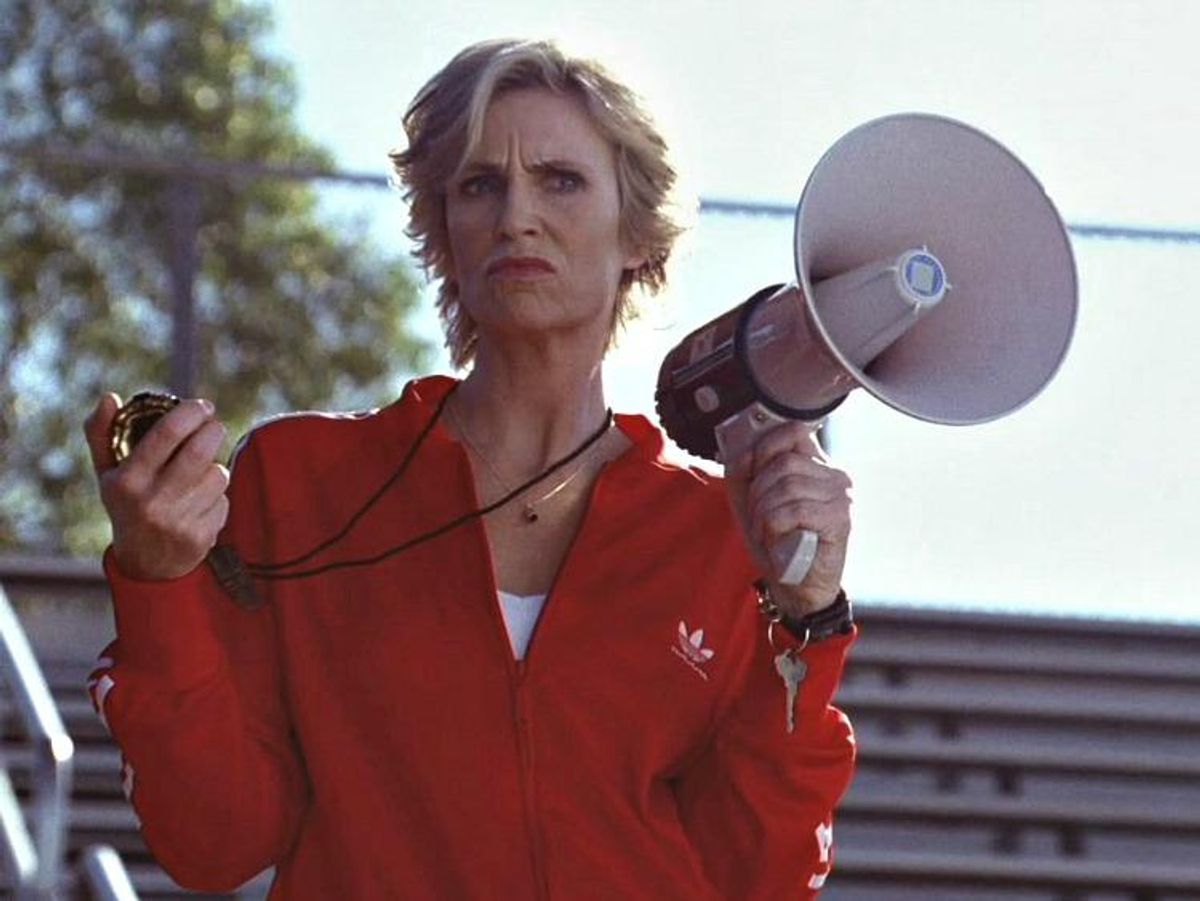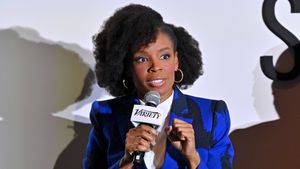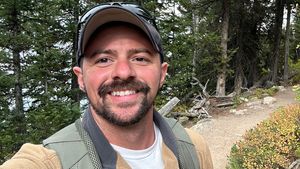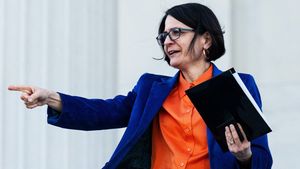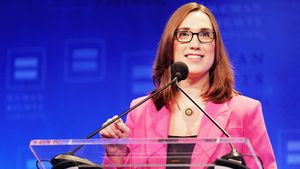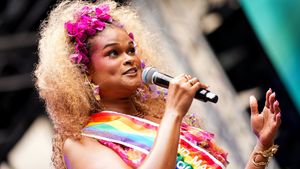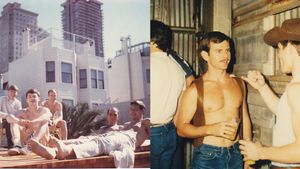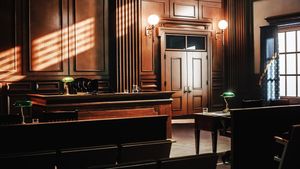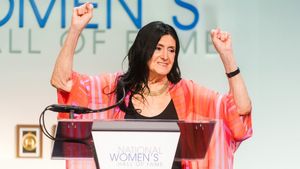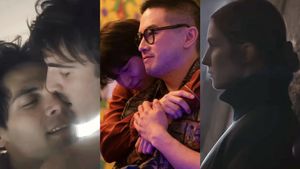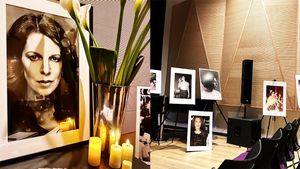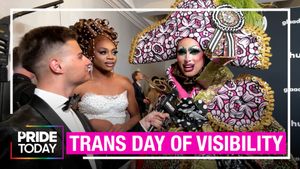As ready as they were going to be after weeks of rehearsal, Glee began filming in late in 2008, using two actual schools for production: one was Long Beach's Cabrillo High, the other was Burbank's John Burroughs High School. Glee's production team later faithfully recreated those locations on the stages of Paramount Studios, but with just a pilot on order borrowed sets were more cost effective. For many actors, it was their first time on a proper set of any kind, while others had extensive experience, but felt like Glee was something special and different right from the start.
READ | PART 1: Casting Call & PART 2: The Rehearsal
Stephen Tobolowsky (Sandy Ryerson): This was not like any television experience I'd ever had in my life. But, it was very much like many theater experiences I had in my life. It was very much like doing summer stock, it was very much like doing reparatory theory around the country. There was a camaraderie with everyone. No one was on iPhone or iPads, people were getting in corners practicing a song or a dance. It was an exciting environment to be a part of I have rarely been in shows where that existed and the shows are not successful. When there's that kind of work ethic on the set, it is almost always a sign that the show will be successful.
Lea Michele (Rachel Berry): I remember being very nervous. My first scene I shot was just a scene by myself. But Ryan told me after that I did a great job and I felt so much better.
Jenna Ushkowitz (Tina Cohen-Chang): "For Sit Down You're Rocking The Boat," we had polished it, I felt. And when we got to the shoot Ryan said, "Now be as bad as you possibly can." That was the first day on set. We just couldn't stop laughing at ourselves.
Tobolowsky:My first day on the set we were shooting at a school in Burbank. We shot the interior of the music room and the principals office. I think we were shooting on a Sunday, so we could use the real school. And then for the auditorium and the football field we drove all the way out to Long Beach to use a high school there. After the show became successful, they spent [a lot of money] rebuilding those schools and those offices as Paramount. That music room was linoleum tile to linoleum tile exactly identical to that music room. The auditorium was exactly the same, from the carpet to chairs.
Naya Rivera (Santana Lopez): The first person that I met was Dianna, because we were sharing a trailer. We had the really small trailers that had the divider in the middle, so we met and opened it up so we could have more space. We became really fast friends because we did our scenes together, and her character wasn't yet in the glee club either. So she hadn't met all the other kids who had already been in rehearsals for a week together. It felt kind of like a clique right off the bat. Like, "who are these originals, they don't want to talk to us!" But that all changed quickly as we got into the series.
Kevin McHale (Artie Abrams): My first scene was that Porta-Potty scene, so it was me, Cory and Mark [Salling]. The biggest thing I remember from that day is we're filming that montage bit, where he's pushing me back to the glee club. We see that guy who taught him to sing, and he's watering the football field and signing. I remember we were sitting there, and the camera was over our shoulder and he goes, "This is crazy." And I said, "this feels like a moment we'll remember for the rest of our lives." He said back, "This feels so special, like we're making something classic." I remember that moment with him -- I have goosebumps now. The scale of it kind of set in. We were in awe of what we had been fortunate enough to get involved in.
Chris Colfer (Kurt Hummel): My first scene was the opening of the pilot where I got tossed into the dumpster. I was amazed how long it took to shoot everything -- it was a major culture shock. The scene was less than a minute long and it took about four hours to film. I couldn't believe how many people worked on a television show either, and I spent hours asking the crew questions about what they did. I also spent my first morning on set in extra's holding because I didn't know where to go. Eventually someone found me and took me to my trailer, but it was a rough start.
Zach Woodlee (Choreographer): The auditions moment in the pilot, they shot them live. They just put the kids up there and shot them live. None of us really knew what was happening. Most of the crew had seen them either in scenes or just doing "Sit Down You're Rocking The Boat," never taking the stage by themselves. That's when crew realized they're real talent. That was a nice moment.

Iqbal Theba (Principal Figgins): As soon as I walked in I had a scene with Lea Michele and Stephen Tobolowsky, my first scene, where he's crying because he's been accused of inappropriate behavior. He was so wonderful. And Lea was so wonderful as well.
Tobolowsky: In Burbank, that first day, what strikes me is how much fun we had. Everybody was laughing so hard after every take. Just having a party. It was not sophisticated, it was not like we were a success. Sometimes you can have a celebration while you're doing a show and it gets in the way of a show, but I felt that the celebration ended up on film. That pilot you can feel that celebration.
Patrick Gallagher (Coach Ken Tanaka): It was around Canadian Thanksgiving that we started shooting in Long Beach. It was so new. I think the first scene I did was the coffee scene with Jane, and I remember thinking she was hilarious. It was a matter for me trying to find the right balance, the kind of bombastic with him and the reality. I remember trying to figure out what kind of tone we were doing. I felt more self conscious than I thought I would. I remember thinking, "I don't know if people are going to get it." For me, it was a different experience shooting before it aired. After it aired, it became a phenomenon. It felt like something I'd never seen, when we shot it.
Rivera:I met Ryan when he was directing the pilot. At that point I didn't know if I would be coming back at all. Ryan just walked up to Dianna and I at one point and said, "You need to learn "Say A Little Prayer." And I go, "Hi, I'm Naya, what is that?" And he says, "It's a song by so-and-so, and you might be singing it the next episode." And then he walked away, just like that.
Woodlee: I remember Amber had to say, "Hell to the no," and she couldn't do it. She literally could not say it. We probably did it 15 times. Now that she's Mercedes Jones, she can do anything.
Ushkowitz:There was one scene where we couldn't stop laughing. The part where Chris is talking about nailing the furniture to the roof, and the pee balloons. Every time Amber would have a honking laugh come out, and then we all couldn't stop laughing. That scene took way longer than it should have, just because of that.
Rivera:In the pilot it was really one off to me, in my mind. I figured I would play her as a bitchy sidekick. But after that, when I was sitting in a choir room with a ton of people, I would think, " How will I stand out without having any lines." I told my husband the other day, I was like rolling my eyes and popping my neck for every joke. I wanted that camera on me.
Lou Eyrich (Costume Designer): Ryan's very hands on with the development of characters. I don't know where a lot of his ideas were based on, if he was using people from his past. For Tanaka he always wanted him in shorts, no matter what. Knee high socks with stripes, and bright shirts that were a little too tight. He always had this sleazy '70s vibe.
Gallagher:About the clothes, it was, "Patrick the person hates this, but Ken Tanaka loves this. Let's make these shirts as small as they can, let's raise these shorts higher." The fanny pack was all me. I remember I needed a place to put my phone, my sides, and candy. But I did it because I thought it would be funny, because I literally, honestly wore won in the '90s. They did make the runways in Milan the next year, I will point out. I didn't think of it until halfway through the pilot, so that's when it appears. I did, as Ken Tanaka, keep an old condom in [my fanny pack]. It was on the side pocket, it would help me play Ken. I didn't want anybody to know, so there were times when I forgot to take it out, and I'd have to run back to props to get it back. It was just a private joke to me as an actor, no one knew. Ken just wanted love so badly.
Eyrich: For Rachel, we did one round of fittings with Ryan and I thinking she was going to be kooky and out there. Ponytail on top of the head, mixing all types of prints. It just looked too forced. We watched movies like Election and Clueless, things that inspired me to go a different direction. It wasn't that she was nerdy-geeky, it was that she was a little inappropriate. Too youthful for high school mixed with a too short skirt. Kind of like Ali MacGraw on Lovestruck.
Michele: In the pilot we experimented with some really out there looks, but halfway through the episode Ryan had us scale them back a bit. So you can see in some scenes like the principals office I have a ton of accessories on but on the bleachers with Mr. Schue she's much more toned down. We even re-shot a few scenes so we could change the wardrobe.
Eyrich:We started with the A-line skirts for the cheerleaders, but when we did the carwash scene [in episode 3], we wanted something more sexy, so then we changed it up. We would go back and forth between the styles. We opted more toward the carwash ones, because they looked better on more body types.
Rivera:I remember them giving me that cheerleading uniform, and I thought it was so cool because I'd never played a cheerleader before, it was super cute. Had I known I would only be wearing that for the next three years straight, I probably would have thought different. We shot outdoors at an actual high school, and we did a bathroom scene with Rachel where we told her to shave her mustache or something.
Eyrich:The bigger challenge is what (the cast) would wear during the dance performances. We did a lot of research on glee choirs, and some of the outfits were so cheesy. We decided to do more a heightened version of matching ensembles. Ryan had a lot of ideas already when I walked in, and we created it together.
Woodlee:I had an audition and picked my top [dances, for rival show choir Vocal Adrenaline], and laid them out on a table for Ryan, and he said yes. Originally, I think the performance was four minutes long, and I had asked if it could be shorter. Ryan said no. So I had two days to put four minutes on these dancers, and then of course the scene shrinks. After the pilot is when they decided they wanted more music in every episode. But four minutes, those kids were dead tired. One girl, she threw her neck out in the middle of it. My assistant had to put on her dress, so if you watch the cut it goes from a blonde to a redhead to a blonde to a redhead. It's kind of funny.
Eyrich: I had never done any kind of show clothes. It was a huge learning curve for me. I definitely learned the hard way. In this case, because I'd never done it before, everybody had to have dance pants underneath because the skirts are going to go up. Or if the girls are wearing sequins it's not a great idea because the boys arms get cut up. On "Rehab" we had to have a lot of extra dresses because they were just blowing out of them. That was a very big dance number. Whenever Vocal Adrenaline danced, we knew it was going to be very active. It wasn't that way with the New Directions. They were more of a glee club, where vocal adrenaline is "Show choir!"
Woodlee:The crazy thing about the show is you have to keep it in context. So it was always going to be a heightened version of a showchoir. Show choirs can't do that kind of dancing with the singing at the same time. It was about keeping it very proscenium. It just becomes a lot of math. I have so many binders that all look like football plays. In the big scheme of things, that's how most of the numbers are, they're very mathematical. Ryan's major thing was precision. He wanted to look down a line of dancers and everyone be perfectly in line. So it was making it as clean, and sharp and mechanical as possible. With is different from our glee club. He wanted Vocal Adrenaline to be a machine that has no heart to it.
Eyrich:The red shirts for "Don't Stop Believin' " was going to be a whole different outfit. They were going to be in a show choir look. The night before about 6 p.m., Ryan found me and said Fox didn't want them in a show choir look because these kids were just starting out, and were the underdogs, and wanted them to look like it. We ran all over town to American Apparel and Urban Outfitters, wherever we could, to try and find something to match the red and whip out costumes that look homemade but could hold up. We tried to dress each one in the flavor of their character.
Ushkowitz: "Don't Stop Believin' " took a day and half to do. I think we did it 75 times. We started counting.
Woodlee:For "Don't Stop Believin' " we tried everything. I tried to teach Chris how to do knee slides, we got the knee pads, and I slid across the floor. I mean, he went to his knees, and then to his face. So I was like, "Let's not do that." I'd say to Ryan: "That's not working." Then he said he wanted interpretive sign language dancing. So we tried a version like that. [Laughs] Eventually I was like, "Ryan, listen, what we can do is this." I showed him the version with mic stands and Cory on the drums. It turned out to be sweet, just iconically sweet. You don't judge them because they're just having a good time. I think that was the essence of the show.
NEXT & FINAL PART: THE PREMIERE!
